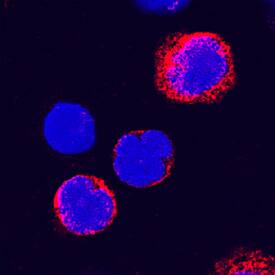Human ADAM8 Ectodomain Antibody
R&D Systems, part of Bio-Techne | Catalog # AF1031


Key Product Details
Species Reactivity
Validated:
Cited:
Applications
Validated:
Cited:
Label
Antibody Source
Product Specifications
Immunogen
Glu158-Ser653
Accession # P78325
Specificity
Clonality
Host
Isotype
Scientific Data Images for Human ADAM8 Ectodomain Antibody
ADAM8 in Human PBMCs.
ADAM8 was detected in immersion fixed human peripheral blood mononuclear cells (PBMCs) using Goat Anti-Human ADAM8 Ectodomain Antigen Affinity-purified Polyclonal Antibody (Catalog # AF1031) at 15 µg/mL for 3 hours at room temperature. Cells were stained using the NorthernLights™ 557-conjugated Anti-Goat IgG Secondary Antibody (red; Catalog # NL001) and counterstained with DAPI (blue). Specific staining was localized to cytoplasmic. View our protocol for Fluorescent ICC Staining of Non-adherent Cells.Applications for Human ADAM8 Ectodomain Antibody
Immunocytochemistry
Sample: Immersion fixed human peripheral blood mononuclear cells (PBMCs)
Immunoprecipitation
Sample: Conditioned cell culture medium spiked with Recombinant Human ADAM8 aa 158-497 (Catalog # 1031-AD), see our available Western blot detection antibodies
Western Blot
Sample: Recombinant Human ADAM8 aa 158-497 (Catalog # 1031-AD)
Reviewed Applications
Read 3 reviews rated 4.3 using AF1031 in the following applications:
Formulation, Preparation, and Storage
Purification
Reconstitution
Formulation
Shipping
Stability & Storage
- 12 months from date of receipt, -20 to -70 °C as supplied.
- 1 month, 2 to 8 °C under sterile conditions after reconstitution.
- 6 months, -20 to -70 °C under sterile conditions after reconstitution.
Background: ADAM8
ADAM8, also known as cell surface antigen MS2 or CD156a, is a member of the ADAM family that contains a disintegrin and metalloprotease-like domain (1, 2). ADAM8 can cleave a variety of substrates and has been shown as a sheddase for the low affinity IgE receptor CD23 and the neural recognition molecule CHL1 (3, 4). Expression and regulation studies suggest that ADAM8 is a novel osteoclast stimulating factor and may play a role in asthma (5, 6). The 824 amino acid precursor of human ADAM8 consists of a signal peptide (residues 1 to 16), a pro peptide (residues 17 to 199), a metaloprotease domain (residues 200 to 400), a disintegrin-like domain (residues 408 to 494), a cysteine-rich region (residues 497 to 613), an EGF-like domain (residues 614 to 640), a transmembrane region (residues 656 to 676) and a cytoplasmic domain (residues 677 to 824).
References
- Yoshiyama, K. et al. (1997) Genomics 41:56.
- Moss, M.L. and J.W. Bartsch (2004) Biochemistry 43:7227.
- Fourie, A.M. et al. (2003) J. Biol. Chem. 278:30469.
- Naus, S. et al. (2004) J. Biol. Chem. 279:16083.
- Choi, S.J. et al. (2001) J. Bone Miner. Res. 16:814.
- King, N.E. et al. (2004) Am. J. Respir. Cell Mol. Biol. 31:257.
Long Name
Alternate Names
Entrez Gene IDs
Gene Symbol
UniProt
Additional ADAM8 Products
Product Documents for Human ADAM8 Ectodomain Antibody
Product Specific Notices for Human ADAM8 Ectodomain Antibody
For research use only